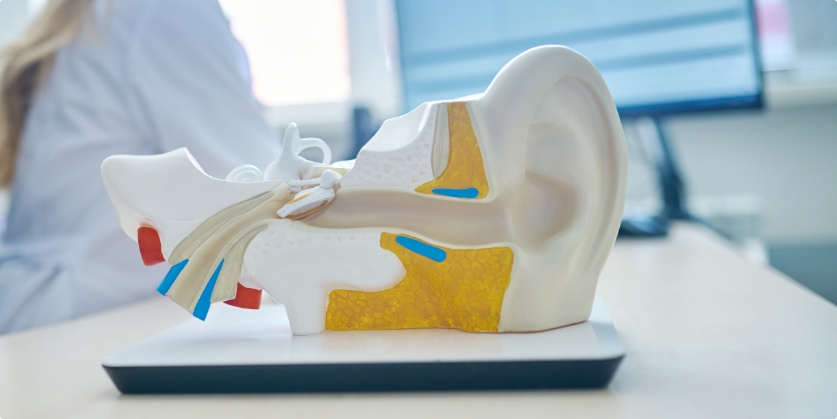Hearing Loss and Aging: What Everyone Over 50 Should Know
As we age, we will experience various changes in our physical health and
Our Elizabethtown Office has MOVED to 939 East Main St. Mount Joy, PA! Learn More →

By: admin | May 31, 2024
Hearing loss in just one ear can be both puzzling and concerning. This situation, known as unilateral hearing loss, may seem less severe than losing hearing in both ears, but it brings its own unique set of challenges. It can make it difficult to pinpoint sounds or understand speech in noisy settings. So, why does this happen? What causes hearing loss in just one ear while the other remains unaffected? If you’re dealing with this issue or know someone who is, this article will help answer these questions. We aim to shed light on the causes and implications of unilateral hearing loss, without drowning you in technical jargon.
The reasons behind single-ear hearing loss can be as diverse as the individuals experiencing it. From a simple ear infection to more complex issues such as Meniere’s disease, numerous factors can lead to this situation. It’s not always a clear-cut case of “why” and “how”.
So, are there any clear signs of single-sided hearing loss? Difficulty understanding speech when there’s background noise or trouble locating where a sound is coming from are common indicators. If you notice these signs or any other changes in your hearing, it’s important to contact a hearing health professional promptly. Early detection and treatment can help lessen the effects of single-sided hearing loss and ensure you continue enjoying life’s soundtrack without missing a beat.
Grasping how our ears process sounds can help us better understand the challenges of single-sided hearing loss. Essentially, our ears work together, each playing a crucial role in capturing and interpreting sounds from our surroundings. When one ear is compromised, it disrupts this teamwork, leading to issues with sound localization and speech understanding.
Sound processing begins when sound waves enter the outer ear and travel down the ear canal to hit the eardrum. This causes the eardrum to vibrate, transferring these vibrations to three tiny bones in the middle ear known as ossicles. The ossicles amplify these vibrations and send them into the inner ear or cochlea, which is filled with fluid and lined with thousands of tiny hair cells.
As the fluid in the cochlea moves, it bends these hair cells, creating electrical signals that are sent to your brain via the auditory nerve. Your brain then interprets these signals as sound. If one ear isn’t functioning properly due to hearing loss, this process is disrupted leading to challenges in understanding speech or locating where a sound is coming from. To ensure optimal hearing health, regular check-ups with your audiologist are essential so any changes can be detected early on.
Understanding the origins of one-sided hearing loss is crucial to managing its effects. This situation can stem from various causes, each with its own implications.
In some cases, one-sided hearing loss may be due to an obstruction or infection in the ear. Alternatively, it could be a symptom of a more serious condition like Meniere’s disease or acoustic neuroma. This highlights the importance of seeking professional help when changes in your hearing are noticed. Your hearing health professional will conduct thorough tests and offer appropriate treatment options based on your specific situation.
Aging is a natural process that brings about various changes in our bodies, and our hearing is no exception. As we grow older, it’s not uncommon to experience changes in our hearing abilities.
One of these changes could be single-ear hearing loss. It’s important to understand that age-related hearing loss usually affects both ears equally. However, there are instances where aging can influence single-sided hearing loss. Here are a few reasons:
If you notice any change in your ability to hear with one ear, it’s important to consult a hearing health professional promptly. They will guide you through the necessary steps for diagnosis and treatment options tailored for your specific needs.
Noise exposure is often a silent culprit in hearing loss, and it’s no different when it comes to unilateral hearing loss. Constant exposure to loud sounds can gradually damage the delicate structures within your ear, leading to potential hearing loss. This risk is amplified if the noise is frequently louder in one ear than the other.
For example, if you often use earbuds at high volumes or work in an environment with loud machinery predominantly on one side, you might find yourself with hearing loss in just that one ear. It’s also possible for sudden, extremely loud noises (like an explosion or gunshot) to cause immediate and severe unilateral hearing loss.
So, what can you do? The first step is awareness – knowing that noise exposure can lead to unilateral hearing loss is half the battle won. The next step involves taking precautions such as wearing protective gear if you’re in a noisy environment or keeping your music volume at safe levels. If you suspect any changes in your hearing, don’t hesitate – reach out to a hearing health professional right away. Early detection and intervention can make all the difference!
Certain medical conditions can contribute to single-ear hearing loss. Some of these include otosclerosis, a situation where an abnormal growth in the middle ear impedes sound transmission, and acoustic neuroma, a noncancerous tumor on the nerve that connects the ear to the brain. Another condition, labyrinthitis, which is inflammation of the inner ear usually caused by an infection, can also lead to unilateral hearing loss.
Challenges can arise when trying to pinpoint which medical condition may be causing your single-ear hearing loss. It’s important to consult with a hearing health professional who can guide you through accurate diagnosis and treatment. They have the expertise to determine if your hearing loss is due to one of these conditions or another factor altogether. By seeking help promptly when you notice changes in your hearing, you’re taking an important step towards maintaining your connection with the world around you.
Trauma can significantly impact one ear’s hearing ability. An injury to the head or a sudden, loud noise can cause immediate and severe hearing loss in one ear.
When trauma occurs, it can damage the delicate structures within your ear that are responsible for transmitting sound to your brain. This disruption can lead to challenges such as difficulty understanding speech in noisy environments or trouble determining where sounds are coming from. If you experience any changes in your hearing following a traumatic event, it’s important to consult with a hearing health professional promptly. They will conduct necessary tests and provide treatment options tailored to your specific situation.
Recognizing the signs of unilateral hearing loss is an important step towards seeking help and finding solutions. Unilateral hearing loss can manifest itself in a variety of ways. Here are some common indicators:
If you notice any of these signs, it’s important to reach out to a hearing health professional promptly. They can conduct comprehensive tests to confirm whether you have unilateral hearing loss and guide you through the next steps.
The challenges that come with unilateral hearing loss can be disconcerting. However, know that you’re not alone – many people face similar issues and there’s a wealth of resources available to help you manage this situation. Your journey towards better hearing health begins with awareness – recognizing the signs and seeking professional help at the earliest.
It’s okay to ask for help when it comes to your hearing health. You don’t have to figure everything out on your own. Hearing health professionals are there for exactly this reason – they’re trained and ready to assist you on your path towards better hearing health.
The road to understanding single-ear hearing loss is not always a straight one. With its unique challenges and effects, it can often feel like a maze that you’re trying to make sense of. The first step towards managing these hurdles is understanding them. Single-sided hearing loss can disrupt your ability to locate sounds or understand speech in noisy environments, making even simple tasks feel like a struggle.
The hazards of single-ear hearing loss extend beyond just the physical implications. It can also have an impact on your mental and emotional well-being. Feelings of frustration or isolation may creep in as you try to cope with the changes in your hearing abilities. However, it’s important to know that help is available and you’re not alone in this.
Acknowledging these hurdles and hazards is important, but it’s equally important not to let them define your experience with hearing loss. With the right support from hearing health professionals and loved ones, managing single-sided hearing loss becomes easier. Every challenge faced is an opportunity for growth and resilience.
Detecting a one-sided hearing deficiency involves specific procedures carried out by a hearing health professional. These tests are designed to identify the presence and extent of hearing loss in one ear.
A common method used is pure-tone testing, which measures your ability to hear different pitches and volumes. Another test, speech audiometry, assesses your ability to understand speech from background noise. Early detection can greatly help in managing one-sided hearing loss. With the guidance of a skilled audiologist, you’re on the right track towards better hearing health.
Dealing with single-ear hearing loss may seem overwhelming, but there are many treatment options available that can help. These treatments aim to improve your hearing and make daily tasks easier.
Choosing the right treatment path depends on several factors, including the cause of your hearing loss, its severity and your lifestyle needs. It’s important to consult with a hearing health professional who can guide you through these options and help determine the best course of action for you.
It’s okay if things seem confusing at first. With time, patience and professional guidance, you’ll find a solution that works for you. You’re not alone in this – there are many resources available to support you along the way. With proper treatment, single-ear hearing loss is a challenge that can be managed effectively.
As we learn more about single-ear hearing loss, it’s important to also consider how we can protect our ears from further damage. Our hearing is precious, and taking steps to protect it can make a significant difference in our overall hearing health.
One of the most effective strategies is limiting exposure to loud noises, which are known to cause damage to the delicate structures within the ear. This could mean turning down the volume on your headphones or wearing protective gear if you work in a noisy environment. Regular check-ups with your hearing health professional are also essential for early detection of any changes in your hearing. Protecting your ears today can help ensure better hearing health tomorrow.
As we conclude this discussion on unilateral hearing loss, it’s clear that understanding and addressing this condition can be a complex journey. But know that you’re not alone. There are professionals ready to assist and guide you through this process. If you’re experiencing symptoms of single-sided hearing loss or have any concerns about your hearing health, don’t hesitate to reach out for help.
At Jul Hearing Aid Solutions in Elizabethtown, PA, our team of dedicated audiologists is here to support you every step of the way. We offer comprehensive assessments and personalized solutions tailored to your unique needs. To learn more or schedule an appointment, please call us at (717) 207-9600.
Tags: faqs, hearing loss and mental health, hearing loss testing

As we age, we will experience various changes in our physical health and
By: admin | December 28, 2023

Technology is advancing at such a fast rate that we’re seeing its
By: admin | November 25, 2023

Julie Nelson—the owner, operator, and hearing instrument specialist at
By: tinashyverplank | September 21, 2021
